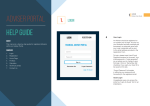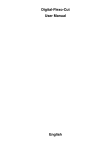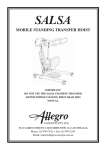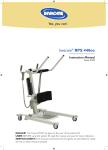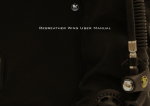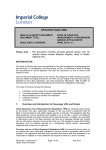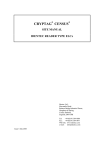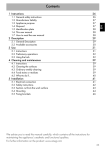Download User Manual
Transcript
Operating Instructions Easy Line, Basic Line Boiling pan DOC. NO. ST0 9168-60 EDITIoN 1 2014.01 9 fig.5 fig.5 1. 2. 3. 4. 5. 6. 7. 8. 9. 10. 11. 12. 13. 14. 4 Pilot lamp Power control Tilt Hot water connection, DN15 (G1/2") Cold water connection, DN15 (G1/2") Electrical junction box. Connection from front. Tap for hot and cold water. Left pillar. Only supplied on special order. Steam trap Safety valve Vacuum valve Floor drain. Only supplied on special order. Flange for test gauge Gauge 14 10 11 13 General description of product Before taking the pan into use These directions for use apply to Boiling pan Easy Line/Basic Line. Additional information is given in our manual entitled ‘Cooking’*. IMPORTANT. Pressure Pans are covered by the requirements of the Factories. Act through the Health and Safety Executive. Additional special insurance cover is required. For insurance purposes a copy of the Appliance Test Certificate must be available prior to appliance insurance inspection clearance and held at all times. Inspection via the Insurance Company will be required 26 months after commisioning and every 12 months thereafter. A plate on the rear of the pan gives the values. * Not supplied. Can be ordered from the supplier or the supplier’s representative. General instructions If the instructions given in this and other documents are not followed, the safety of the product may well be jeopardised, and the supplier’s warranty commitment and product liability will no longer be valid. • Read the instructions in this document carefully as they contain important safety information relating to installation, operational reliability, use, and maintenance of the product. Keep the document in a place where it is available for all users. All service, maintenance, and repair of this product must be performed by a specially trained technician. Only genuine parts may be used when replacing parts. Refer to the Service instructions* and Parts catalogue*. Handling and maintenance of this product must be performed only by a specially trained operator. When the cooking vessel is in operation, only the operator should be in the immediate vicinity of the vessel. • • • * Not supplied. Can be ordered from the supplier or the supplier’s representative. Range of application The Boiling pan is designed for cooking and shall on no condition be used in any other way or for any purpose other than what is described in these directions for use. Boiling pans Easy Line/Basic Line can be used for cooking, heating and mixing food products. CE - Direktiv The Easy Line/Basic Line is manufactured in accordance with the directive MD 2006/42/EG, LVD 2006/95/EG, EMC 2004/108/ EG and are CE-marked. (fig 1) WEEE The symbol on the product indicates that this product should not be treated as domestic waste, but must be correctly disposed of in order to prevent possible negative consequences for the environment and the human health. Regarding the recycling of this product, please contact the sales agent or dealer of your product, your after-sales service or the appropriate waste disposal service. 22 Filling the pressure vessel with water Must be carried out by trained personnel. Before the cooking vessel is taken into service, the pressure vessel must be filled with water. Pan with automatic water filling of vessel See fig.5 NB! Water must be connected in before the pan is energized. • When the boiling pan is energized the vessel fills automatically with water to the right level. Pan without automatic water filling of vessel See fig.5 • Turn "Tilting" and set the boiling pan at approximately a 45° incline.The lid must be up before the boiling pan is tipped. • Unscrew the plug at the back of the cooking vessel. • Fill with water through the nipple, up to the hole. • Turn “Stop tilting” and reset the boiling pan to work position. The excess water will run out until the correct water level is reached in the cooking vessel. • Using the appropriate tool, replace the plug. Ensure that the sealing washer is still in place on the plug. Neither steam nor water should leak out when the cooking vessel reaches its operating pressure. The water level in the vessel should be checked at least once in a month. Safety instructions Switch off the current supply before remedying any faults or operational disruption. • Adjust the ”Operating switch” (2) to pos. 0.The signal lamp will go out. • Switch off the ‘Isolating switch’ (Not on the boiling pan). Warning! Electricity! The warning sign shown in fig. 2 identifies the electrical control unit of the machine. The cover plate for the electrical cabinet and other cover plates may be opened only by specially trained technicians. Warning! Hot The warning sign shown in fig. 3 warns of heat and steam. Care should be exercised as high temperatures can come into question. Warning! Do not aim a jet of water directly at the pillar or the outer side of the boiling pan. - If water comes into contact with ‘live’ parts of the boiling pan, this would be extremely dangerous.You should always be very careful when cleaning close to electric parts. - Use a slightly moist rag when cleaning. Safety valve Vacuum valve Vacuumvalve fig. 7 pos. E opens at fast cooling down of hot boiling pan. Operator information Before working on the product, the operator should: - acquire sufficiently good knowledge of handling and maintenance; - locate every warning plate and clarify their purpose; - read through the safety instructions and warning texts very carefully. - read the General instructions. Automatic water filling See fig.5 The water level for the heating elements in the steam jacket must be inspected regularly. Pan with automatic water filling of the steam jacket adjusts the water level automatically. The water level in the steam jacket for the pan without automatic water filling is inspected manually. A properly functioning safety valve is a vital part of the boiling pan´s safety system. The safety valve opens, fig. 7; A, when the pressure exceeds 0,5 bar. • Switch off the cooking vessel immediately and call in a trained technician. • Continuing to flow out water through the safety valve, shut off the incoming water at the shutoff valve and contact qualified technician. Warning! If the safety valve opens, fig. 7 pos. A, hot steam will blow out from the valve. Regular checks of the safety valve must be carried out by trained personnel. SAQ recommends: once per week. Checking the safety valve • Lift the handle so that the steam has a free passage through the safety valve, fig. 7A; A:1 and 7A; A:2. If the valve cannot be made to “blow” it should be replaced immediately. Call in a trained technician. Pressure gauge Pressure gauge fig. 7 pos. B, for the steam pressure. Must not exceed 0,5 bar. If the pointer is entering the red field • Interrupt the operation and call for a trained technician. Steam trap The steam trap, fig. 7 pos.C, releases the cold air from the steam generator when the boiling pan is started. When the water in the steam generator begins to boil and hot steam starts to stream out, close the steam trap. 23 Cleaning Supplementary equipment and accessories After use and for daily cleaning of the boiling pan • Use a neutral washing-up agent + warm water. - Empty the vessel, wash out and rinse thoroughly. • Be extra thorough during cleaning and rinsing if salt has been used during cooking in the pan. Salt which is allowed to become dried on can damage the cooking receptacle surface. • The cooking vessel’s external stainless steel surfaces should also be cleaned with warm water, where necessary combined with a neutral washing up/cleaning agent and a soft brush or sponge. • The panel and knobs should be wiped with a damp cloth. • Do not use steel wool or abrasive cleaning agents when cleaning stainless steel surfaces. • Do not use cleaning agents containing chlorine (e.g. chlorine bleach). Chlorine and chlorine compounds which come into contact with stainless steel can damage the surface. Equipment Dipstick For hard (calcium rich) water Dry the boiling pan on the inside after use each day with a soft cloth or paper dampened with vinegar. When the equipment is not in use Follow the instructions given below when the boiling pan is not used for a longer period of time. • Clean the boiling pan. • Switch off the boiling pan at the main switch • Adjust the ”Operating switch” (2) to pos. 0.The signal lamp will go out. • Switch off the ‘Isolating switch’. (Not on the boiling pan). • Open the lid to allow air to circulate and thus prevent mould and bad smell developing in a closed space. • Switch off the water supply. Call in trained personnel. Fig 1 24 Fig 2 Accessories Strainer plate Insert baskets Lift hooks Bottom cross-piece Cooling coil Technical data Data plate (fig. 4) The product number of the boiling pan is given on the data plate, which is located on the side of the boiling pan pillar and in the junction room, and also on the manufacturer´s declaration enclosed with the product on delivery. Sound level: <70 dB Other documents Manufacturer´s declaration Installation instructions Service instructions* Spare parts catalogue* Cooking manual* * Not supplied. Can be ordered from the supplier or the supplier’s representative. Fig 3 Fig 4 SWITCH ON/OFF Adjust the ”Operating switch for heating” (2) to position 0. Signal lamp (1) will go out. When signal lamp is out the heating of the boiling pan is disconnected. ➥ ➥ Adjust the ”Operating switch for heating” (2) to position for desired heating level. Signal lamp (1) lights up. When signal lamp is light the heating of the boiling pan is connected up when the boiling is in working position. TILTING OF PAN ➥ Adjust the ”Tilting” in counter clockwise direction towards the symbol for tilting. The boiling pan stops in its position when the knob is let or by max. tilting position. The knob will automatically go back to normal position when let go. A. Safety valve B. Pressure gauge C. Steam trap D. Measuring tap (for HSE or other accredited body when inspecting) E. Vacuum valve C Adjust the ”Tilting return” clockwise towards the symbol for working position. The boiling pan stops in its position when the knob is let, or when it reach it’s working postion. The knob will automatically go back to normal position when let go. 1. 2. 3. 4. 5. ➥ Signal lamp Operating switch heating Position/symbol for tilting Position/symbol for tilting return Knob for tilt/-return B AE D 1 2 3 Fig. 7 4 5 A:1. A:2. Fig. 6 Fig. 7A 25






